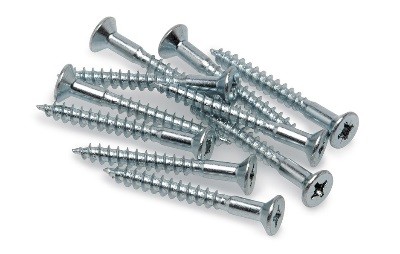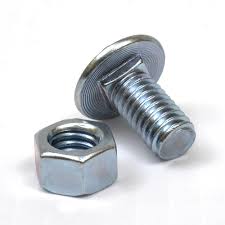Types of fixings

|

|

|

|
Contents |
[edit] Introduction
Fixings (or fasteners) are used to hold things together or to attach them to the surfaces such as walls, floors or roof. They are a form of connector and play an indispensable role in construction.
Choosing the right fixing for the particular job is important. Typical fixings include:
[edit] Nails
Nails are an ancient method of holding two items together and although crude, they are relatively cheap and simple to use. They are mainly used in timber applications for example, to hold together glued joints, for attaching plasterboard to walls and ceilings, and for nailing down floorboards and roof battens.
There are many types available and include:
- Round, plain-head wire nails
- Lath nail
- Clout nail
- Roofing nail
- Cut clasp nail
- Pipe nail
- Tack
- Upholstery nail
- Panel pin
- Staple
For more information see: Types of nail
[edit] Screws
Unlike nails which are hammered in, screws require fixing with a screwdriver. For this purpose, they come with various head shapes – slotted, cross-head (Phillips) or other – and in a choice of materials. When fixing materials together or attaching items to a wall, screws can be preferable to nails as they typically give a better clamping force and can also be removed and reinstated in a reverse process to that of fixing.
When used in masonry walls however, rawl plugs are required to give a better grip into the material being fixed into, whether masonry or concrete. In these applications, screws are not driven into the wall directly but into a rawl plug (usually plastic) that is inserted into a drilled hole. These are available in moulded or extruded plastic or the traditional fibre material. Expansion sleeves are also available for use with masonry nails and are used for fixing wall linings and skirting boards.
In woodwork, when screws are used with an adhesive, there is usually no need to temporarily clamp together the two pieces as might be needed when just using an adhesive.
Screws are typically made of mild steel, but are also available in corrosion-resistant stainless steel and brass. Some may also be plated with zinc, chrome or brass.
The typical elements of a screw are:
- The head, which determines which type of screwdriver can be used – e.g whether cross-head or slotted – and allows the screw to be driven. The screw head itself can take various forms according to the work in hand. These include countersunk, roundhead (or domed), raised head, mirror screws or pan head (self-tapping)
- The shaft, which comprises a shank (and which acts as a dowel) below the head, and the threaded portion which is generally around two thirds of the shaft length and ends in a point to allow easier starting.
Screws are usually described by their length and their shank diameter (gauge or SWG – usually a number from 1-20).
Other accessories that can be used with screws include caps, cups and sockets.
For more information see: Types of screw.
[edit] Nuts and bolts
A bolt is a type of fastener, usually made from metal, that commonly comprises a head at one end, a chamfer at the other, and a shaft characterised by an external helical ridge known as a ‘thread’. Bolts are typically used to hold materials or objects together, or to position objects.
The chamfer at the opposite end of the head provides a slightly bevelled edge which helps with inserting the bolt into holes and nuts. Bolts typically (but not always) require a nut which is applied via torque while the bolt is held in place (or vice versa). Vibration or dynamic loads may loosen nuts, necessitating the use of locknuts, lock washers or thread lockers which can provide resistance to loosening.
For more information see: Types of bolt and Types of nut.
[edit] Special plugs (anchors)
A range of special wall fixings are available which can be used to provide fixings in hollow walls. As the screw is turned into the anchor/ fixing, grippers expand to apply a force on the other side of the material, be it plasterboard or ply etc, thereby giving a good grip and fixing.
[edit] Rivets
A rivet is a mechanical fastener for making a permanent join between two or more metal sheets. Riveting is the act of fastening or securing two plates with one or more rivets. The rivet comprises a shank with a plain end (or tail), and a head on the other end. The rivet has proved to be one of the most reliable and safe means of fastening, forming a permanent and structurally robust join.
For more information see: Rivet.
[edit] Adhesives
Adhesives are bonding agents used to join materials by glueing.
For more information see: Adhesives.
[edit] Welding
Welding is a technique that can be used to join metallic components through the application of heat. It produces a secure and strong joint by combining two metals into one rather than other processes such as brazing and soldering that bond the pieces together.
For more information see: Welding.
[edit] Others
Other types of fixing include:
NB A fixture is '...an asset that is installed or otherwise fixed in or to a building or land so as to become part of that building or land in law’ (for example, a boiler)'. Ref HMRC
[edit] Related articles on Designing Buildings
Featured articles and news
ECA progress on Welsh Recharging Electrical Skills Charter
Working hard to make progress on the ‘asks’ of the Recharging Electrical Skills Charter at the Senedd in Wales.
A brief history from 1890s to 2020s.
CIOB and CORBON combine forces
To elevate professional standards in Nigeria’s construction industry.
Amendment to the GB Energy Bill welcomed by ECA
Move prevents nationally-owned energy company from investing in solar panels produced by modern slavery.
Gregor Harvie argues that AI is state-sanctioned theft of IP.
Heat pumps, vehicle chargers and heating appliances must be sold with smart functionality.
Experimental AI housing target help for councils
Experimental AI could help councils meet housing targets by digitising records.
New-style degrees set for reformed ARB accreditation
Following the ARB Tomorrow's Architects competency outcomes for Architects.
BSRIA Occupant Wellbeing survey BOW
Occupant satisfaction and wellbeing tool inc. physical environment, indoor facilities, functionality and accessibility.
Preserving, waterproofing and decorating buildings.
Many resources for visitors aswell as new features for members.
Using technology to empower communities
The Community data platform; capturing the DNA of a place and fostering participation, for better design.
Heat pump and wind turbine sound calculations for PDRs
MCS publish updated sound calculation standards for permitted development installations.
Homes England creates largest housing-led site in the North
Successful, 34 hectare land acquisition with the residential allocation now completed.
Scottish apprenticeship training proposals
General support although better accountability and transparency is sought.
The history of building regulations
A story of belated action in response to crisis.
Moisture, fire safety and emerging trends in living walls
How wet is your wall?
Current policy explained and newly published consultation by the UK and Welsh Governments.
British architecture 1919–39. Book review.
Conservation of listed prefabs in Moseley.
Energy industry calls for urgent reform.



























